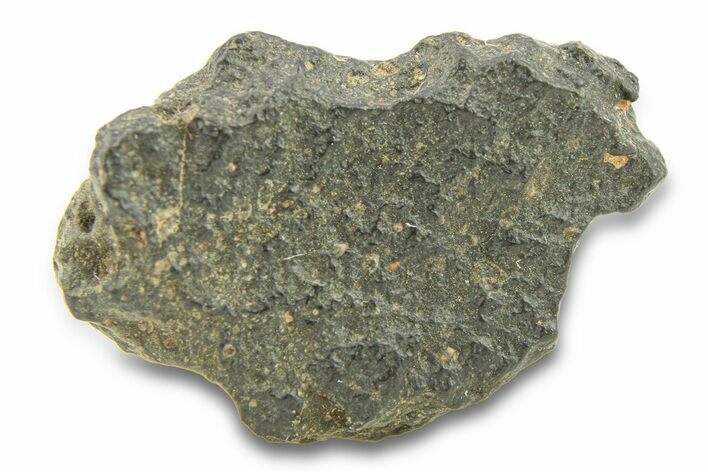.61" Abadla 002 CM2 Chondrite Meteorite (0.93 g) - Algeria
This is an incredibly rare specimen: a .61" wide fragment of the Abadla 002 carbanaceous chondrite meteorite! It comes in an acrylic display case.
The Abadla 002 meteorite spans between several individual pieces, found in Algeria in the first half of December 2021. It is a CM2 carbonaceous chondrite with a dark, thick fusion crust and rather sparse chondrules set in a gray matrix, which is what about half of the specimens consist of. About 800 total grams are known.
Carbonaceous chondrites consist of about 5 percent of known chondrites. They contain the highest concentrations of water, organic, and volatile compounds of all chondrites, and, true to their name, contain carbonate minerals! These chondrites are the least oxidized, indicating they came from the outer asteroid belt or beyond. Because of their unique compositions, they are some of the most frequently studied meteorites in the world, and have been considered as an origin for life due to their abundance of organic compounds, including amino acids.
Due to their complexity and variety, carbonaceous chondrites have several sub-classes grouped by chondrule width, each named after the type specimens of each class. CI carbonaceous chondrites, the class of finest grains, are named for the Ivuna meteorite that fell in Tanzania in 1938. CI chondrites almost entirely lack chondrules, and are composed mostly of fine-grained material that underwent aqueous alteration on their parent asteroids. Their chemical composition most closely resembles the sun’s photosphere of any chondrite. Other notable classes include:
CO and CM (Ornans/Mighei), with the smallest chondrules;
CR (Renazzo), CB (Bencubbin) and CH (high metal), which contain unique chondrules that formed from impacts after normal chondrules formed;
CV (Vigarano) and CK (Karoonda), two groups with distinctively large chondrules that formed only once at the beginning of the solar system; and
CL (Loongana), which contain large chondrule and calcium-aluminum-rich inclusions, or CAIs, but low amounts of volatile compounds and matrix.
Due to their complexity and variety, carbonaceous chondrites have several sub-classes grouped by chondrule width, each named after the type specimens of each class. CI carbonaceous chondrites, the class of finest grains, are named for the Ivuna meteorite that fell in Tanzania in 1938. CI chondrites almost entirely lack chondrules, and are composed mostly of fine-grained material that underwent aqueous alteration on their parent asteroids. Their chemical composition most closely resembles the sun’s photosphere of any chondrite. Other notable classes include:
About Chondrites
A chondrite is a stony (non-metallic) meteorite that has not been modified by either melting or differentiation of the parent body. Chondrites are formed when various types of dust and small grains in the early Solar System accreted to form primitive asteroids. Some such bodies are captured in the planet’s gravity well and pulled to the surface. They are by far the most common type of meteorite, representing about 86 percent of all meteorites that have fallen to Earth.
Prominent among the components present in chondrites are the enigmatic chondrules, millimeter-sized spherical objects that originated as freely floating, molten or partially molten droplets in space; most chondrules are rich in the silicate minerals olivine and pyroxene. Chondrites also contain particles of various metals such as nickel, iron, and aluminum. These formed at the very beginning of the solar system and aggregated over time: they are the oldest rocks known on Earth!
Chondrites are divided into about fifteen distinct groups on the basis of their mineralogy, bulk chemical composition, and oxygen isotope compositions. The various chondrite groups likely originated on separate asteroids or groups of related asteroids. Each chondrite group has a distinctive mixture of chondrules, refractory inclusions, matrix (dust), characteristic chondrule sizes, and other components. Other ways of classifying chondrites include weathering and shock. The L chondrite group is the most common of these.
A chondrite is a stony (non-metallic) meteorite that has not been modified by either melting or differentiation of the parent body. Chondrites are formed when various types of dust and small grains in the early Solar System accreted to form primitive asteroids. Some such bodies are captured in the planet’s gravity well and pulled to the surface. They are by far the most common type of meteorite, representing about 86 percent of all meteorites that have fallen to Earth.
Prominent among the components present in chondrites are the enigmatic chondrules, millimeter-sized spherical objects that originated as freely floating, molten or partially molten droplets in space; most chondrules are rich in the silicate minerals olivine and pyroxene. Chondrites also contain particles of various metals such as nickel, iron, and aluminum. These formed at the very beginning of the solar system and aggregated over time: they are the oldest rocks known on Earth!
Chondrites are divided into about fifteen distinct groups on the basis of their mineralogy, bulk chemical composition, and oxygen isotope compositions. The various chondrite groups likely originated on separate asteroids or groups of related asteroids. Each chondrite group has a distinctive mixture of chondrules, refractory inclusions, matrix (dust), characteristic chondrule sizes, and other components. Other ways of classifying chondrites include weathering and shock. The L chondrite group is the most common of these.
TYPE
Carbonaceous Chondrite (CM2)
AGE
LOCATION
Near Abadla, Algeria
SIZE
.61" wide, Weight: 0.93 g
CATEGORY
ITEM
#291490
 Reviews
Reviews









